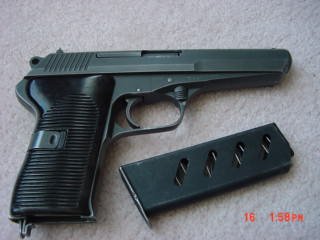
*CZ-52 Pistol*

At the time of manufacture the pistol had some very novel features. The most notable was the ammunition it shot. The 7.62X25 round the Czech's used is noted for it's high velocity. In parts of Asia where the round is commonly encountered , local police forces have their soft body armor "Tokarev" rated. By that specification the armor manufacturer has to toughen the product to defeat the fast 7.62X25 Soviet loading which is shot out of the Tokarev TT30, TT33 and all variants . The CZ-52 was designed to use the Czech M48 Submachinegun round interchangeably with the PPSH( pronounced pay pay shaw), which is loaded a full 20% hotter than the comparable Soviet offering. These rounds are rated at 1600 feet per second. In the service pistol world that's an extremely fast loading.
To achieve this feat, the designers employed a novel but hardly unique approach. They stole the idea from someone else. The German MG42 General Purpose Machine gun used a pair of rollers which locked the breech at the moment of firing and that idea was one the Czech's stole.. When the barrel rebounds these rollers are cammed into slot and the barrel becomes unlocked. The slide at this point retracts and the round is ejected. The slide goes forward, camming the rollers into their cam faces, locking the barrel. Many readers familiar with German H&K products know the locking rollers in the model 91, 93, and MP5 along with their P9 pistol series. The CZ-52 uses the same system.
The other interesting point about the CZ-52 is the decocking lever that allows the operator to lower the hammer on a loaded chamber with out placing their fingers on the hammer. CAUTION: Some of these pistols are known to accidentally discharge due to worn parts in the decocker mechanical linkage circuit. The user would be advised to verify this function several times prior to using it and to practice safe handling techniques at all times.
The pistols were all originally made with a gray Phosphate finish. Some of them have been refurbished with a dark bluing that approaches black. On the left side of My pistol frame is the serial number and the letter code "rid" that stands for the CZ factory. On the right side of the frame is a pair of crossed swords (acceptance proofs) and a number showing the year of manufacture. In my case that number is 54. Century Arms in their usual crappy manner have their importation stamp and 7.62 TOK stamped there. The barrel also has the serial number which matches the rest of the gun. There is also a "T" enclosed with in a circle on the barrel. One source I've read said that means the pistol was returned to the factory and the decocking circuit verified by CZ and this proof is to verify that. On the top of the frame is the serial number that matches the rest of the gun. During the 1970's some of the pistols were refurbished and the Letters VOZ along with the year of refurbishment appear above the trigger. I'm told that is where the dark blue pistols come from.
To shoot the pistol, place the safety in the bottom position with the red dot exposed. Place a loaded magazine in the weapon. Rack the slide back and release. The pistol is now ready to shoot. When all eight rounds are shot the magazine release will hold the slide in the rearward position. To release the magazine push the magazine catch to the rear of the weapon.
As issued the decocker can be actuated by pushing the safety up from the safe position which will cause the hammer to fall. As the pistol was originally built with a passive Walther type firing pin lock (another thing they borrowed) it is completly safe from having the hammer strike it until the trigger is completly pulled. It is therefore safe to carry the pistol loaded with a round in the chamber and the hammer down because dropping the pistol on the hammer will not allow the firing pin to move due to this safety.
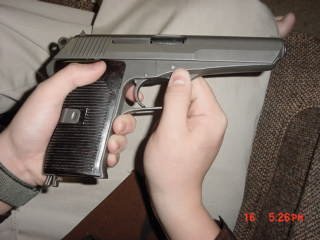
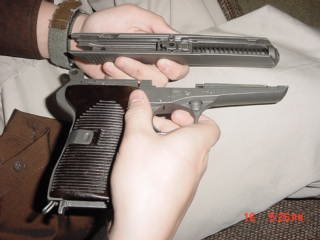
To field strip the pistol, grasp it as shown in the photo. Pull down
on the dismount catches and then push forward and up to remove the
slide group. What you'll then have is illustrated in the second photo.
To remove the barrel assembly from the slide you then can use a screwdriver or magazine to pull the barrel assembly from the slide and while doing that pull it up to disengage the rollers from their respective locks in the slide. Be careful at this point because the barrel is under spring pressure and even though it is not as energetic as some I've played with it can get away from you and cause injury.
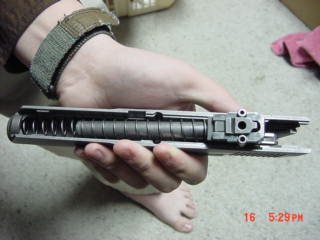
When you break the firing pin(and you will if you dry fire it) to remove it turn the slide upside down and depress the plunger underneath in the center of the slide a until it bottoms out. This will allow you to remove the firing pin. There are after market firing pins which I have in my gun and I highly recommend. They fix the broken pin problem and greatly improve the good trigger these guns have.
To remove the grips take a screwdriver and pop the retaining clip off. There's nothing to see under there but get it out of your system. The grip panels are a crude bakalite type plastic and chip easily. That's why I don't recommend screwing with them any more than you need to.
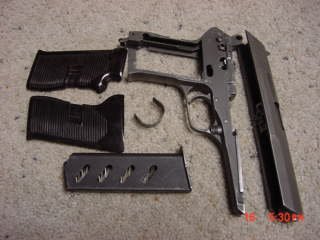
When you get the pistol the first thing I would do is to field strip it and take the grips off. Then using a can of carburator cleaner and wearing glasses spray out the 40 year old grease from inside the frame. You can unscrew the lock plate if you want but be advised you can strip out the threads from the nut real easy if you're not careful. I did that and had to use Loc-Tite to keep it snug from then on.
Then I would dry fire it about 20 times to be sure the cast steel firing pin was broken. Next I'd buy a milled replacement firing pin and replace it.This will do two things. First it will get rid of the only weak point in the weapon. Second it will improve the trigger. Depending on what type of replacemant firing pin you use the decocking feature will not work after installation so read the instructions that come with the pin and perform your own test as to if the pistol will discharge with it in place. I never use a decocker and until I read about it on the discussion boards I didn't even know it existed.
That would be the only other thing I would do to the pistol. It shoots nicely for me. The 7.62X25 round will bring a smile on your face. It is very accurate. The sights are for GI's in that they are minimal but very rugged.
Be advised the 7.62X25 is a firebreather and will get your attention.
Muzzle blast is quite apparent. One of the reasons I got my pistol was
the fact the ammunition has the potential for hand loading to some very
spectacular performance levels. I've read on the boards of people getting
over 2000 FPS (so they say) using a 32acp bullet and Winchester 296 powder.
I haven't done that but you could get .357 mag level performance using
Speer 110gr Plinker bullets. I'm working on a sabot load using the 55Gr
.223 full metal jacket bullet. I feel this has the potential of being very
effective against soft armored targets.
Serger
All materials at this site not otherwise credited are Copyright © 1996 - 2002 Trip Williams. All rights reserved. May be reproduced for personal use only. Use of any material contained herein is subject to stated terms or written permission.